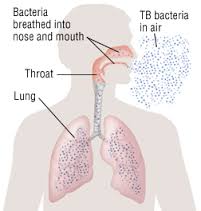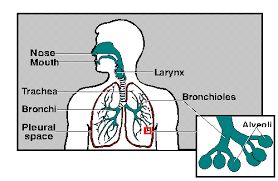Tuberculosis is a common infection in Nigeria caused by the TB bacteria (Mycobacterium tuberculosis). And so it is important to understand the basics and infection process of the disease.
TUBERCULOSIS is commonly abbreviated and called TB.
- A person becomes infected with TB after airborne droplets containing Mycobacterium tuberculosis are inhaled.

- When an infected person has released them into the air (by sneezing, talking, coughing, shouting, laughing or singing), they remain in the air for many hours. And the number of TB bacteria required for the infection to be initiated is small (less than 10).

The respiratory tract
- When the TB bacteria (Mycobacterium tuberculosis) are inhaled through the nose and/or mouth, they travel through the respiratory tract until they get to the alveoli in the lungs.
- In the lungs, cells of the body’s immune system (called macrophages) recognize that the TB bacteria are foreign. So, the macrophages engulf the bacteria.
- Usually, when macrophages eat up foreign bodies, they break them down. But the TB bacteria prevent this from happening. This allows them to stay alive inside the macrophage.
- Then, the mycobacteria begin to multiply inside the macrophages.
- Some weeks later, the macrophages that are infected with the TB mycobacteria are surrounded by some other cells of the body’s immune system (forming a granuloma, also called ghon focus). This is to control the infection and prevent it from spreading.
- The process results in the death of the lung tissue that is surrounded.
- This initial exposure to TB is known as the primary infection.
- Sometimes, all the TB bacteria are killed. And other times, even though they are surrounded and walled off, they remain alive but are just dormant.
- This is called a latent or dormant infection of tuberculosis – which means the primary infection is latent or dormant, and does not progress. In this type of TB infection, the person is infected but does not have the symptoms and cannot infect other people. Latent TB infection is the most common type of TB infection – 95% of those who are infected with TB have the latent/dormant infection.
- The latent infection occurs when the person’s immune system is able to contain the TB infection and prevent it from progressing and spreading.
- If the immune system is weak and not functioning the way it should, then the primary infection will progress. And then, the person will have an active TB infection or disease.
- A person with an active TB disease will have symptoms and will be able to infect other people.
- Also, years after having a latent infection, if at any point the person’s immune system becomes weak (immunosuppressed), then it can progress to an active TB disease. Because the immune system is no longer strong enough to contain the infection and prevent it from progressing and spreading.
- Different things can weaken a person’s immune system.
- When the primary TB infection that has been latent for some time – months or years), is reactivated and progresses, it is referred to as a secondary infection. A secondary TB infection is not always due to reactivation of a previously latent/dormant infection; sometimes, it occurs as a result of a re-infection.
- The TB infection can go beyond affecting just the lungs to infect other organs in the body. This spreading of the TB bacteria to other parts of the body is called dissemination.
Knowing the process of tuberculosis infection is important. Knowledge is power afterall!









